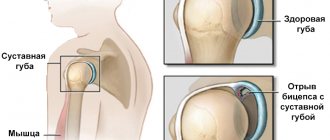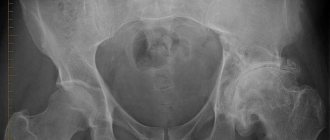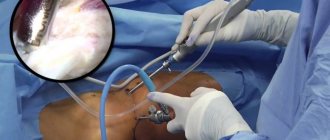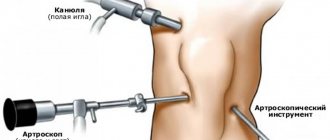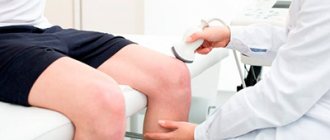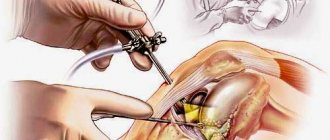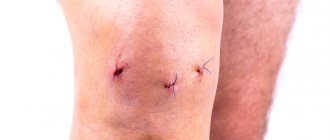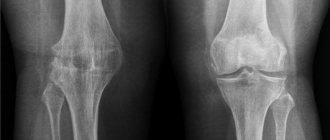Intra-articular ligaments control the level of mobility of the articular joint. Excessive activity can stretch or tear connective tissues. There are three degrees of severity of such damage:
- first - moderate pain when moving, slight swelling;
- second - intense pain, difficulty in joint movement due to rupture of part of the fibers, hematoma and tissue swelling occurs;
- third - pronounced pain, loss of joint mobility, severe swelling, hematoma.
Grade 3 injuries are most often associated with ligament rupture. The injury occurs mainly at the site of attachment of the ligament to the bone, sometimes accompanied by dislocation of the joint. Treatment tactics are developed after determining the extent of damage. Ligament surgery is performed to restore the integrity of a ligament after it has been torn. Surgical intervention is used for grade 3 injuries, if conservative therapy does not lead to complete recovery. Improper treatment leads to the gradual development of arthrosis of the joint.
Features of the procedure
The operation is performed using the classic open method through a deep surgical incision or in a minimally invasive manner using arthroscopy. The duration of rehabilitation directly depends on the method chosen by the specialist. With arthroscopy, restoration of joint mobility takes less time.
There are several methods of surgical treatment of ligaments:
- stitching of damaged tissues using microsurgical reconstruction;
- replacement of injured tissues with autografts from healthy ligaments;
- restoration of ligaments using allograft (donor material).
Plasty of the cruciate ligament of the knee joint
Cruciate ligaments of the knee joint
Plasty of the cruciate ligament is prescribed for old injuries received more than two months ago. Such operations are performed only by experienced, highly qualified surgeons. The intervention is successfully carried out by specialists from the Open Clinic. Our operations are performed by doctors with the highest qualification category, so we are confident in the excellent results of plastic surgery.
The clinic’s doctors use a modern treatment method, namely arthroscopy. The advantages of such an intervention are minimally invasive, safe and affordable. During the operation, doctors do not open the joint, but carry out all manipulations through incisions no larger than 1 cm.
Thanks to this, the patient’s rehabilitation period after the intervention is significantly reduced. Already on the second day after surgery, the patient can stand on his leg. Doctors usually remove sutures after 10 days. A person is allowed to return to sports no earlier than six months after the intervention. But the patient can ride a bike and swim after 4 weeks.
Plasty of the cruciate ligament of the knee joint
During the operation, doctors insert instruments and an arthroscope with a camera into the incisions, which transmits the image to the screen. Despite the fact that the technique is gentle and minimally invasive, the patient still requires anesthesia. General or local (spinal) anesthesia is used.
Plastic surgery of the anterior cruciate ligament of the knee joint involves replacing damaged tissues with new ones. Both natural ligaments and artificial grafts are used. Young people's own semitendinosus tendons are taken for plastic surgery. They are fixed with modern fasteners, which after some time grow into the bone and completely dissolve.
The procedure is highly precise and leaves no scars or scars. In our clinic, cruciate ligament plastic surgery is performed using the latest generation of precision equipment. This allows specialists to carry out interventions at the highest level.
After the operation, the patient will have to undergo rehabilitation. Its duration depends on the success of the intervention, the presence or absence of complications. It is important that the patient is monitored by a surgeon during the recovery process. The doctor will be able to monitor the correctness of rehabilitation and promptly identify any violations. A person can play sports again and return to his usual work rhythm only after receiving permission from a doctor.
Treatment of fractures
Surgical treatment of calcaneal fractures - from 39,500 rubles to 79,500, depending on the complexity of the fracture
- Stay in the clinic (inpatient)
- Anesthesia (anesthesia or epidural)
- Operation: Osteosynthesis of a calcaneal fracture
- Consumables (rods, plate and screws from leading global manufacturers)
* Tests for surgery are not included in the price
Surgical treatment of fractures of the toes and metatarsal bones - from 19,500 rubles to 59,500 depending on the complexity of the fracture
- Stay in the clinic (inpatient)
- Anesthesia (anesthesia or epidural)
- Operation: Osteosynthesis of a fracture of the metatarsal bone or phalanges of the fingers
- Consumables (rods, plate and screws from leading global manufacturers)
* Tests for surgery are not included in the price
Operation to remove metal structures from the foot - from 29,000 to 49,000 rubles, depending on the complexity
- Stay at the clinic
- Anesthesia
- Operation
- Consumables for surgery
*Tests for hospitalization are not included in the price
Treatment of foot deformities and flat feet
Reconstruction of feet with hallux valgus (one foot) - from 39,000 to 49,000 rubles, two feet - from 69,000 to 99,000 rubles, depending on the degree of deformation
- Stay at the clinic
- Anesthesia (epidural)
- Reconstructive surgery on the forefoot
- Consumables and special screws for surgery
*Tests for hospitalization and post-operative shoes are not included in the price
Reconstruction for deformation of small toes (one foot) - from 21,000 to 29,000 rubles, two feet - from 29,000 to 39,000 rubles, depending on the degree of deformation
- Stay at the clinic
- Anesthesia (epidural)
- Surgery on little toes
- Consumables and special screws for surgery
*Tests for hospitalization and post-operative shoes are not included in the price
Organ-preserving surgery on the first toe for arthrosis (one foot) - 39,000 rubles, two feet - 59,000 rubles
- Stay at the clinic
- Anesthesia (epidural)
- Surgery cheilectomy and osteotomy of the first metatarsal (SCARF)
- Consumables and special screws for surgery
*Tests for hospitalization and post-operative shoes are not included in the price
Arthrodesis of the metatarsophalangeal joint for arthrosis (one foot) - 39,000 rubles, two feet - 59,000 rubles
- Stay at the clinic
- Anesthesia (epidural)
- Operation including consumables and special screws
*Tests for hospitalization and post-operative shoes are not included in the price
Endoprosthetics of the first metatarsophalangeal joint for arthrosis - price on request
- Stay at the clinic
- Anesthesia (epidural)
- Big toe joint replacement surgery
- Consumables and imported endoprosthesis
*Tests for hospitalization and post-operative shoes are not included in the price
Reconstruction for deformation of the fifth toe (one foot) - 34,000 rubles, two feet - 49,000 rubles
- Stay at the clinic
- Anesthesia (epidural)
- Surgery on the fifth toe
- Consumables and special screws for surgery
*Tests for hospitalization and post-operative shoes are not included in the price
Reconstruction of feet for longitudinal flatfoot 1-2 degrees. — from 39,000 to 69,000 rubles depending on the degree of deformation, volume of surgery and number of implants
- Stay at the clinic
- Anesthesia (epidural)
- Foot surgery for flat feet
- Consumables and special screws for surgery
*Tests for hospitalization are not included in the price
Reconstruction of feet for longitudinal flatfoot 2-3 degrees. — from 69,000 to 99,000 rubles depending on the degree of deformation, volume of surgery and number of implants
- Stay at the clinic
- Anesthesia (epidural)
- Foot surgery
- Consumables and special screws for surgery
*Tests for hospitalization are not included in the price
Reconstruction of feet for longitudinal flatfoot grade 3-4. — from 99,000 to 159,000 rubles depending on the degree of deformation, the volume of surgery, and the number of implants
- Stay at the clinic
- Anesthesia (epidural)
- Foot surgery
- Consumables and special screws for surgery
*Tests for hospitalization are not included in the price
Reconstruction of feet with hallux valgus and transverse flatfoot (one foot) - from 39,000 to 49,000 rubles, two feet - from 69,000 to 99,000 rubles, depending on the degree of deformation
- Stay at the clinic
- Anesthesia (epidural)
- Foot surgery
- Consumables and special screws for surgery
*Tests for hospitalization and post-operative shoes are not included in the price
Minimally invasive and arthroscopic surgeries
Surgery to remove Morton's neuroma - 24,000 rubles
- Stay at the clinic
- Anesthesia (epidural)
- Open surgery to remove Morton's neuroma
- Consumables for surgery
*Tests for hospitalization are not included in the price
Endoscopic surgery for plantar fasciitis and heel spurs - 34,000 rubles
- Stay at the clinic
- Anesthesia (epidural)
- Endoscopic surgery for plantar fasciitis and heel spurs
- Consumables for surgery
*Tests for hospitalization are not included in the price
Endoscopic surgery for Achilles tendonitis and Haglund's disease - 34,000 rubles
- Stay at the clinic
- Anesthesia (epidural)
- Endoscopic surgery for Achilles tendon diseases
- Consumables for surgery
*Tests for hospitalization are not included in the price
About cruciate ligament injuries
The cruciate ligaments of the knee are important stabilizing ligaments of the knee that keep the knee joint from moving during movement. The cruciate ligaments also model the correct movement of the knee joint. The cruciate ligaments are located at the very center of the knee joint and serve as the axis of rotation. Injuries to the cruciate ligaments of the knee joint occur by tearing away from their attachment to the femur (sometimes with a bone fragment) or by rupture (complete or partial rupture).
The main problem with a cruciate ligament rupture is a violation of the biomechanics and stability of the knee joint. With constant movement, the tibial plateau shifts and rotational instability of the knee joint occurs. This causes a feeling of instability in the joint, and full coordinated load becomes impossible. Cruciate ligament ruptures lead to constant overload of other elements of the knee joint .
As medical statistics show, cruciate ligament injuries in 70% of all cases lead to damage to the internal meniscus. In 64% of all cases, damage to the meniscus occurs simultaneously at the time of cruciate ligament rupture. In women, cruciate ligament rupture occurs much more often than in men, this is due to the structural features of the female body
Indications and contraindications for surgery
Autoplasty is indicated in the following cases:
- Complete rupture of ligaments.
- Slow healing after using conservative treatment methods.
- Ligamentosis.
- After repeated injuries, which were accompanied by ruptures and sprains.
Among the advantages of such an intervention:
- Transplantation of the patient's own tissue.
- The operation does not lead to loss of joint functionality.
- Transplanted tissue cannot be rejected by the body.
Contraindications for ACL transplantation include:
- Joint contracture, difficult access to soft tissues.
- Inflammatory, purulent processes.
- Exacerbation of severe chronic diseases that do not allow anesthesia.
- Serious pathologies of the cardiovascular system.
- Diseases of the respiratory and urinary tract.
Preparation for arthroscopy
Preparing for arthroscopy involves taking the necessary measures and having the results of a number of examinations in the patient’s hands.
Examinations that must be completed before surgery:
Analyzes:
- Complete blood count (valid for 2 weeks).
- General urine test (valid for 2 weeks).
- RW, HIV, HBS, HCV (valid for 1 month).
- Blood type, Rh factor (valid for 3 months).
- Biochemical blood test from a vein: total protein, ALAT, ASAT, LDH, CPK, bilirubin, urea, creatinine, glucose (good for 2 weeks).
- Coagulogram: PTI, APTT, fibrinogen, prothrombin (valid for 2 weeks).
- Covid-19 (SARS-CoV2) - swab (good for 3 days).
X-rays and studies:
- Fluorography – chest x-ray (valid for 6 months).
- Ultrasound of the vessels of the lower extremities.
- ECG (valid for 2 weeks).
Other:
- Statement of health from a general practitioner with a description of concomitant diseases and recommendations for therapy, continuous use of medications and surgical history.
- Passport.
- Anti-embolic stockings.
Recovery after knee arthroscopy
- A hospital stay after arthroscopy is not required.
- Depending on the situation, the doctor may prescribe anti-inflammatory, painkillers and antibacterial drugs.
- In the future, the patient is prescribed physical therapy and physiotherapeutic treatment aimed at restoring the functionality of the joint.
- The entire recovery period is from 1 to 1.5 months. Strict adherence to all recommendations can significantly reduce the time required for recovery.
Where else is arthroscopy used?
Modern equipment allows this method to be used for almost any joint.
In addition to the knee and shoulder joints, the following are often examined:
- wrist joint;
- elbow joint;
- spinal joints;
- ankle joint;
- joints of the feet.
Contraindications to arthroscopy
Absolute contraindications (conditions in which the surgeon will definitely not perform the operation):
- the general serious condition of the patient, in which surgical interventions are generally contraindicated;
- purulent inflammation in the tissues around the joint - in this case, infection can be introduced into the joint;
- infected wound;
- bone or fibrous ankylosis is a condition in which the joint space is overgrown with bone or dense connective tissue. In this case, movements in the joint become impossible. This can be seen on the x-ray.

